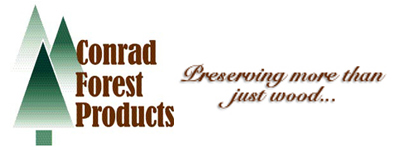Conrad Products Inventory: Species

We're not just wood treaters. All products available treated or untreated.
Douglas Fir-Larch (DF-L)
This species combination has the highest modulus of elasticity (MOE or E) value (the stiffness factor) of all North American softwoods. In strength properties, DF-L has the highest ratings of any Western softwood for fiber stress in bending, tension parallel to grain, horizontal shear, compression perpendicular and compression parallel to grain.
Douglas Fir (DF) is often the standard against which all other framing species are measured. Its strength combined with a superior strength-to-weight ratio, high specific gravity (for excellent nail and metal truss plate-holding capability), excellent dimensional stability (giving "green" DF products the ability to season well in service), the moderate decay resistance of its heartwood, and documented excellent performance record against strong forces resulting from winds, storms and earthquakes, have given Douglas Fir its reputation. It is also tight knotted and close grained, adding the bonus of beauty to its structural capabilities. Color, grain pattern, knot size and type are addressed in the rules for appearance grades.
Hem Fir, Hemlock, & Mixed White Woods
Hem-Fir is a species combination of Western Hemlock and the true firs (Noble, California Red, Grand, Pacific Silver and White fir). With strength properties slightly below DF-L (and above DF-S), this is an extremely versatile species group and useful for multiple, general-purpose framing applications. In the structural framing grades, Hem-Fir is capable of meeting the span requirements of many installations.
Hem-Fir is often considered by those seeking wood with a very light color as the most desirable of the Western softwoods. It is as light or lighter in color than some of the Western pines but stronger. Products are available in structural, appearance and remanufacturing grades. It is easily pressure treated with preservatives, making it useful for decks and other outdoor amenities.
Redwood
There are over thirty different grades of redwood lumber including general purpose grades and specialized grades for a single use. There is a grade of redwood for almost any application suitable for wood. Redwood is graded by appearance and durability, with criteria defined by the Redwood Inspection Service.
Excellence of appearance is a major factor in the grading of redwood. Clearness (freedom from knots) is the determinant for the highest grades. Other grades are categorized by number, size and nature of knots and the presence of other characteristics such as stains, crook or manufacturing defects that may occur.
For durability and resistance against insects and decay-redwood is graded by its color. Reddish-brown heartwood from the inner portion of the tree contains extractives that render it resistant to decay. The cream-colored sapwood that develops in the outer growth layer of the tree does not possess the heartwood's resistance to decay and insects. As a rule of thumb, all heartwood grades of redwood will have the word "Heart" in the grade name.
Port Orford Cedar
Port Orford Cedar is limited in supply and availability. It grows only in a small area of southern Oregon and northern California, and very limited amounts are harvested from private lands and made available, usually only by request. It is priced accordingly. It has a pungent, ginger-like scent, is easily worked, and polishes well. In Japan, it is sometimes substituted for Hinoki when appearance is critical. It is used for small items such as woodenware, novelties and toys.
Western Red Cedar
Western Red Cedar is the largest and most abundant of all cedars in managed forests. It is non-resinous and has a strong spicy scent. Heartwood varies from dark reddish brown to a pinkish color and has excellent weather-resistant properties. Sapwood is light yellow. One of the lightest in weight of the commercially important softwoods, it is often used for houseboats. It is valued for paneling, decks, and greenhouses as well as for siding, posts, fencing, shingles and shakes.
Southern Yellow Pine
Southern Pine grows in a vast band across the Southern United States, from East Texas to Virginia. In fact, it's a rare county that doesn't contain a representative of one of the four main species: shortleaf, longleaf, loblolly or slash. Lumber from all four is marketed as Southern Pine (or Southern Yellow Pine) and graded in accordance with the grading rules of the Southern Pine Inspection Bureau (SPIB), approved by the American Lumber Standard Committee.
